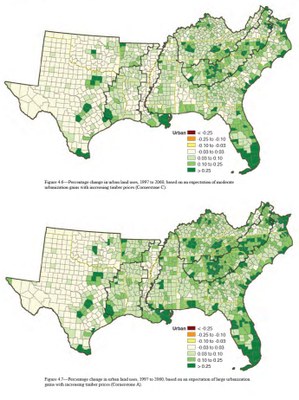The Southern Forest Futures Project: Technical Report
USDA Forest Service's Southern Research Station
This summary is taken from text in the published assessment document referenced below.
Summary
The Southern Forest Futures Project was initiated in 2008 as an effort to study and understand the various forces reshaping forests across the 13 Southeastern States. Chartered by the USDA Forest Service Southern Region and Southern Research Station along with the Southern Group of State Foresters, the effort built from the Southern Forest Resource Assessment (Wear and Greis 2002a, 2002b), which had identified and explored the implications of several forces of change reshaping the region’s forests including land development, new forest pests, and increasing timber demands. These and other changes have continued apace or accelerated since 2002, warranting another look at the implications for southern forests and the many services and values that they provide. The Futures Project was launched with a set of 15 public meetings from across the South to gather a broad range of insights into ongoing changes and anticipated trends affecting forests in the region and local areas. In contrast to public involvement processes for resource planning or administrative decision making—where input focuses on deducing values held by the public and their preferences regarding outcomes—we simply sought information regarding the range of issues, questions, and uncertainties regarding the future of forests and their various goods, services, and values in the South.
 We sought broad participation from all “stakeholders,” including landowners, researchers, nongovernmental organizations, and forestry agencies and information from the public meetings was used to help organize the design of the project (Wear and others 2009). After compiling public input, Phase I of the Futures Project was initiated. This involved constructing forecasts of future forest conditions to the extent possible using a set of future scenarios describing, among other factors, changes in populations, economics, and climate to the year 2060. A set of resource issues (meta-issues) developed from the public input sessions defined a set of questions that needed to be addressed. A lead scientist was identified for each of these meta-issues, research teams were convened, and study plans were developed and thoroughly reviewed. The detailed results of the forecasting and meta-issue teams are described in this technical report. A summary report (Wear and Greis 2012) provides a synthesis and identifies a set of key findings from the technical report.
We sought broad participation from all “stakeholders,” including landowners, researchers, nongovernmental organizations, and forestry agencies and information from the public meetings was used to help organize the design of the project (Wear and others 2009). After compiling public input, Phase I of the Futures Project was initiated. This involved constructing forecasts of future forest conditions to the extent possible using a set of future scenarios describing, among other factors, changes in populations, economics, and climate to the year 2060. A set of resource issues (meta-issues) developed from the public input sessions defined a set of questions that needed to be addressed. A lead scientist was identified for each of these meta-issues, research teams were convened, and study plans were developed and thoroughly reviewed. The detailed results of the forecasting and meta-issue teams are described in this technical report. A summary report (Wear and Greis 2012) provides a synthesis and identifies a set of key findings from the technical report.
A second phase of the Futures Project, ongoing as this report is being completed, examines the findings of the Technical Report from the perspective of each of five separate subregions. We contend that because of the diversity of resource settings in the South, the implications of the Futures Project for management, restoration, and potential policy would vary by subregion. Separate subregional reports are now being completed for the five subregions: (1) AppalachianCumberland, (2) Piedmont, (3) Coastal Plain, (4) Mississippi Alluvial Valley, and (5) Mid-South. In addition to soliciting public input, we have sought expert input from the study team (more than 50 scientists and analysts have been involved) and through peer reviews from many specialists across the region. In addition, we shared the peer reviewed drafts of the summary report and this technical report with the public for their review. All of the reports produced in the Futures Project have greatly benefited from this thorough vetting process. From its inception, the Southern Forest Futures Project has sought to provide an information foundation for evaluating the future of the region’s forests and consequences for its people, and a platform for discussing how to negotiate the future. The ultimate measure of our success will be the extent to which our findings advance these discussions.
The Southern Forest Futures Project provides a science-based “futuring” analysis of the forests of the 13 States of the Southeastern United States. With findings organized in a set of scenarios and using a combination of computer models and science synthesis, the authors of the Southern Forest Futures Project examine a variety of possible futures that could shape forests and the many ecosystem services and values that forests provide. The science findings and modeling results could inform management and policy analysis of the South’s forests. In the chapters of this technical report, the authors provide detailed findings and results as well as sets of key findings and implications.
Preferred citation
Wear, D.N.; Greis, J.G. 2013. The Southern Forest Futures Project: technical report. Gen. Tech. Rep. SRS-178. Asheville, NC: U.S. Department of Agriculture Forest Service, Southern Research Station. 542 p.

























